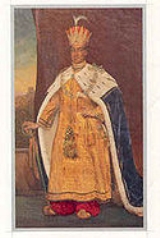
Nasiruddin Haider
Encyclopedia
Nasir-ud-din Haidar (b. c. 1803 – d. 7 July 1837)
was the second King of Oudh
from 19 October 1827 to 7 July 1837.
.
After the death of Ghazi-ud-din Haider his son Nasir-ud-din Haider ascende the throne on October 20, 1827 at the age of 25 years.
He was fond of woman & wine and had a strong belief in Astrology & Astronomy.
He sat up an observatory at Lucknow The Tarunwali Kothi which was bedecked with exceptionally good astronomical instruments.
He made additions of Darshan Vilas, a European style Kothi, to Claude Martin
's house - Farhat Buksh in 1832.
He reproduced a Karbala at lradatnagar for his place of burial.
was the second King of Oudh
Nawab of Awadh
The Nawab of Awadh is the title of rulers who governed the state of Awadh in India in the 18th and 19th century. The Nawabs of Awadh originated form Persia-Establishment:...
from 19 October 1827 to 7 July 1837.
Life
He was the son of Ghaziuddin HaiderGhazi-ud-Din Haider
Ghazi-ud-Din Haider was the last nawab wazir of Oudh from 11 July 1814 to 19 October 1818 and first King of Oudh from 19 October 1818 to 19 October 1827.-Life:...
.
After the death of Ghazi-ud-din Haider his son Nasir-ud-din Haider ascende the throne on October 20, 1827 at the age of 25 years.
He was fond of woman & wine and had a strong belief in Astrology & Astronomy.
He sat up an observatory at Lucknow The Tarunwali Kothi which was bedecked with exceptionally good astronomical instruments.
He made additions of Darshan Vilas, a European style Kothi, to Claude Martin
Claude Martin
Major General Claude Martin was an officer in the French, and later the British, army in India. He rose to the position of Major General in the British East India Company...
's house - Farhat Buksh in 1832.
He reproduced a Karbala at lradatnagar for his place of burial.

